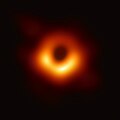
A Q-star, also known as a grey hole, is a hypothetical type of compact, heavy neutron star with an exotic state of matter. Such a star can be smaller than the progenitor star's Schwarzschild radius and have a gravitational pull so strong that some light, but not all light, can escape. [1] Light going in the opposite direction of the star’s center would be the most likely to escape from it, while light going in a direction almost parallel to its surface is the most likely not to escape. Light that does escape from this object will likely be gravitationally redshifted. The Q stands for a conserved particle number. A Q-star may be mistaken for a stellar black hole. [2] Some stellar black holes might be grey holes, two of which are V404 Cygni and Cygnus X-1. [1]
